Rosneath Community Needs Assessment
Overview
As per Cowal, this chapter considers public transport integration, carryings and capacity utilisation and reliability on the Kilcreggan – Gourock route. It thereafter sets out steps 1-4 of the RSM for Rosneath, defining community dependencies, establishing the current and model service and identifying any mismatch between the two. The outcomes of this chapter provide the basis for an appraisal of options (if required) which could address any differential between the current and model service.
Public Transport Integration
As with the Dunoon service, the Kilcreggan ferry connects with rail and bus services to Greenock, Braehead and Glasgow, facilitating access for those living on the Rosneath Peninsula to employment, leisure etc in Inverclyde, Renfrewshire and Glasgow. This section summarises the integration of the ferry service with wider public transport connections on both sides of the crossing.
It is important to note that travel from Kilcreggan to Inverclyde as well as Glasgow is likely to be of importance given limited facilities on the Rosneath Peninsula itself. There is also inbound commuting to Rosneath, which acts as a gateway for the Royal Naval Armaments Depot (RNAD) Coulport and His Majesty’s Naval Base (HMNB) Clyde at Faslane.
Rail – Gourock
There is a relatively high frequency service between Gourock and Glasgow Central, with a mix of all-stop and fast services. Neither the ferry nor the rail service operates on a ‘clockface’ timetable and thus interchange times between ferry and rail differ by service. Appendix C provides a full breakdown of rail connections for ferry arrivals and departures at Gourock (Monday – Saturday), based on the timetable as at 1st December 2022. Key points of note with regards to rail ferry interchange are as follows:
Ferry arrival at Gourock
- Almost all ferries have a connection with a rail service within 25 minutes of arrival, the three exceptions being the 10:06 (32 minutes), 11:06 (32 minutes), and 16:08 (30 minutes).
- Where a sailing connects with a ‘fast’ train from Gourock (five sailings per day), the end-to-end journey time ranges from 60-74 minutes depending on the interchange time between ferry and train. The minimum journey time of 60 minutes (13 minutes on the ferry, nine minutes interchange time and 38 minutes on the train) is very competitive given the distance covered and the incorporation of a ferry crossing within the trip.
Ferry departures from Gourock
- The pattern in the reverse direction is broadly similar – all bar one ferry service has a rail arrival within 20 minutes of departure, the exception being the 14:28 sailing, where the wait between train arrival and ferry departure is 29 minutes.
- Of the thirteen ferry departures Monday – Friday, seven connect with a fast or semi-fast rail service from Glasgow Central, so rail-based integration is of a high quality.
- The 18:13 ferry from Gourock, the last of the day, will be held for a maximum of 12 minutes to 18:25 in the event of a late arriving train. The relatively short length of time that the ferry can be held is likely due to the ferry crew approaching their maximum hours for the day.
Key Point: The Kilcreggan – Gourock service connects well with rail services to / from Gourock, despite neither service being operated on a clockface basis. In the ‘to Glasgow’ direction, minimum journey times can be as little as 60 minutes when the ferry connects with a ‘fast’ train.
Bus – Gourock
The Kilcreggan ferry connects with largely the same buses at Gourock as does the Dunoon ferry, the main bus service being the 901 Clyde Flyer. Whilst rail will always offer a quicker journey to Greenock and Glasgow, the bus may be attractive to those with a National Entitlement Card or who are travelling to a destination or intermediate stops not served by the train, e.g., Braehead or Largs.
The shorter operating day of the Kilcreggan ferry service means that all sailings connect with a 901 Clyde Flyer bus service which, as previously noted, operates on a circa half-hourly frequency throughout the day.
Key Point: All Kilcreggan ferry arrivals and departures connect with a 901 Clyde Flyer bus service at Gourock. However, bus journey times are not competitive with rail and thus the bus market is likely to be largely limited to those with a National Entitlement Card or who are travelling to a destination not served by rail, e.g., Braehead.
Bus – Kilcreggan
The overland journey to Glasgow from Rosneath is not as onerous as travelling from Cowal. Kilcreggan is served by a single bus, the 316 operated by Wilsons of Rhu. This bus:
- Provides bus-based connectivity to / from the Kilcreggan ferry to settlements in Rosneath and on the east side of Gare Loch (e.g., Helensburgh). This includes HMNB Clyde and RNAD Coulport.
- Provides bus-based connections for Rosneath residents to Helensburgh Central station, providing access to an alternative rail connection into Glasgow when the ferry is not operating, e.g., in the evening and on Sundays.
The 316 operates on a broadly half-hourly frequency Monday – Saturday. It also runs over a circa 16-hour operating day, with the first departure from Kilcreggan at 06:12 and the last arrival at 22:32. There is therefore a connecting bus service for all ferries Monday to Saturday but there is variation in the wait times due to the ferry not operating on a clockface timetable.
Sunday frequency is however much poorer, with only six services in each direction calling at Kilcreggan at broadly two hourly intervals between circa 11:30 and 22:30. When combined with the absence of a ferry service from Kilcreggan, Rosneath is very poorly connected on a Sunday.
Key Point: All Kilcreggan ferry services are met by the 316 bus, albeit wait times can on occasions be long in both directions. The bus also provides the alternative connection to Helensburgh (and Helensburgh Central for trains to Glasgow) when the ferry service is not operating, e.g., evenings.
It should be noted that Sunday public transport connectivity to / from Kilcreggan is very poor, with no ferry service and only six return bus services to Helensburgh.
Connectivity analysis
Equivalent connectivity analysis to that carried out for Cowal has also been carried out for Rosneath, again using TRACC. For this analysis, we established travel times by public transport to / from Kilcreggan village centre to Glasgow (George Square) for two scenarios:
- Scenario 1: No ferry service between Kilcreggan and Gourock
- Scenario 2: Current CFL ferry service between Kilcreggan and Gourock
Runs were undertaken for two time periods, within which it has to be possible to undertake the entirety of the journey by public transport:
- AM: 07:00-10:00 (Kilcreggan to Glasgow)
- PM: 16:00-19:00 (Glasgow to Kilcreggan)
A 5-minute wait penalty has again been applied. The journey times for each scenario by time period are summarised in the table below:
| Time Period | Scenario 1 | Scenario 2 |
|---|---|---|
| AM | 95 | 85 |
| PM | 100 | 90 |
The table demonstrates that the Kilcreggan ferry combined with the rail service from Gourock offers a journey time advantage over the alternative option of taking the bus to Helensburgh Central and catching the train from there. There is a particular advantage for the ferry in terms of in-vehicle times, although combined wait and walk times are slightly longer due to a larger number of interchanges. There would be much more significant journey time advantages for those travelling to e.g., Greenock, Paisley etc and for those commuting to Rosneath from Gourock and the surrounding area.
A review of car-based journey times suggests that the ferry / train combination is competitive with car at peak times given journey time variability on the last few miles into Glasgow. Car is likely to be slightly faster in the off-peak, although this can vary depending on traffic conditions.
Key Point: The connectivity analysis demonstrates that the Kilcreggan ferry combined with the train from Gourock offers a journey time advantage for trips to Glasgow when compared to the alternative bus / train combination.
Carryings and Capacity Utilisation
Annual carryings
The table below shows the absolute passenger usage for the Kilcreggan - Gourock route.
| Year | Usage |
|---|---|
| 2012 | 52,600 |
| 2013 | 57,000 |
| 2014 | 54,400 |
| 2015 | 53,600 |
| 2016 | 55,500 |
| 2017 | 41,200 |
| 2018 | 42,900 |
| 2019 | 41,000 |
| 2020 | 16,056 |
| 2021 | 39,329 |
| 2022 | 47,659 |
The figure below shows the trend in passenger usage, indexed to 2012:
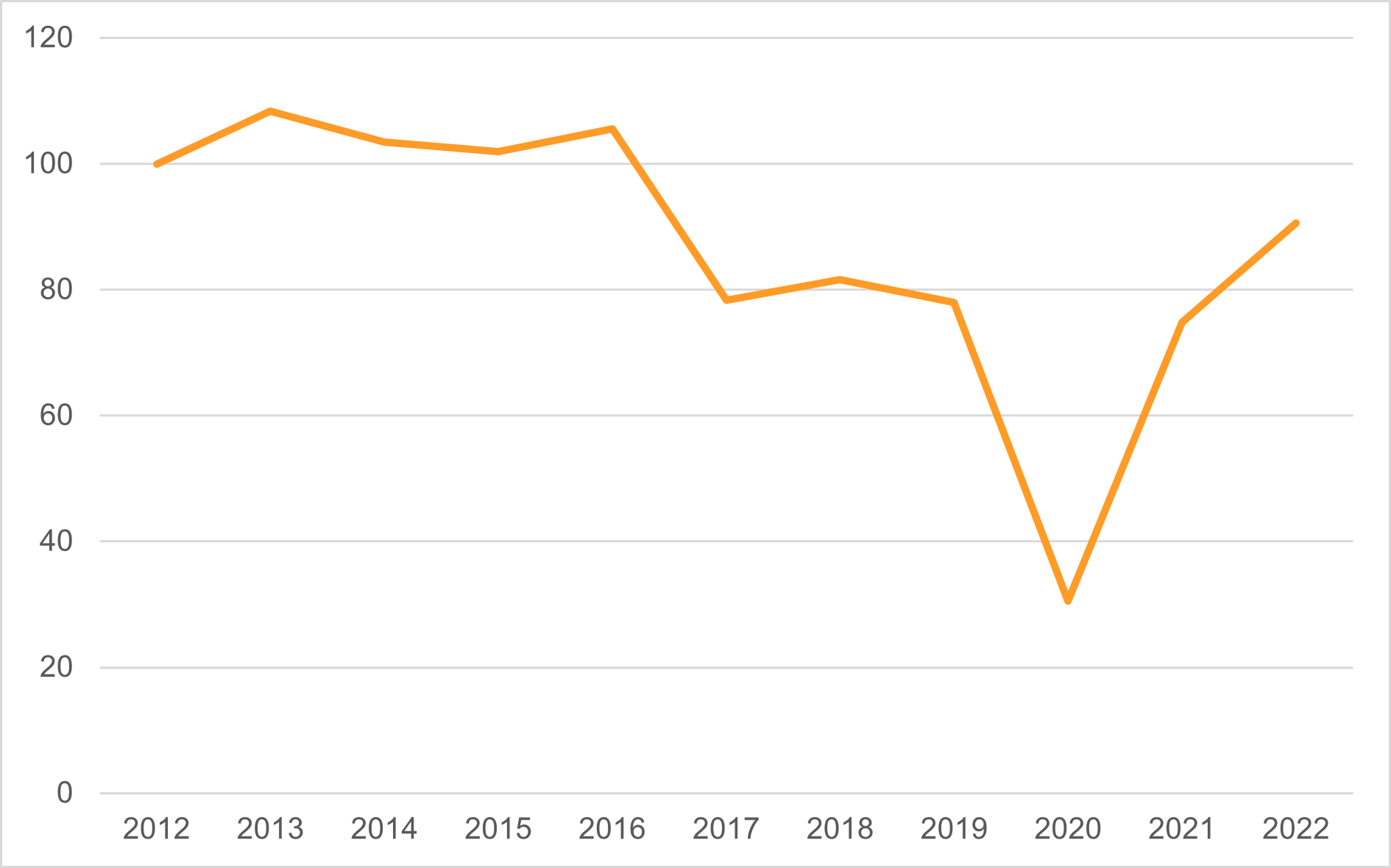
The reliability issues associated with the Kilcreggan service led to a marked decline in carryings from 2016 onwards - indeed carryings since 2017 had hovered around 80% of their 2012 level, albeit they reduced substantially during the pandemic, which was common across all routes. The route is now however on a much more sustainable footing since the transfer of responsibility for services to Transport Scotland / CFL in June 2020. This is reflected in passenger carryings for 2022, which recovered to their highest level since 2016, with almost 7,000 more passengers carried than in 2017.
Key Point: Passenger carryings on the Kilcreggan route reduced by just over 20% between 2016 and 2017 due to reliability issues with the service and have not yet recovered their 2016 level (although 2022 recorded the highest carryings since then, despite the impact of COVID-19). Since CFL has assumed control of the service, reliability has improved, which is reflected in the more recent growth in carryings, which are above their immediate pre-pandemic level.
Carryings by month
The figure below breaks down the annual carryings by month for 2022 (note 2022 has been used as it is likely to most closely represent the new settled position on the route):
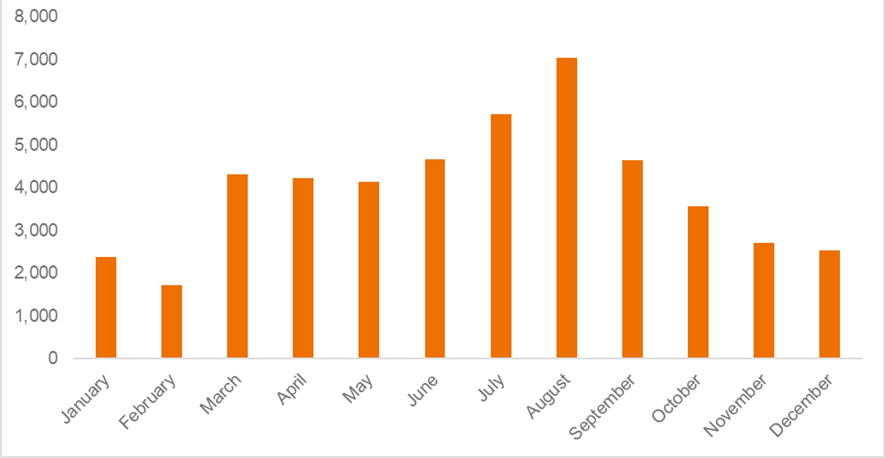
The main points of note from the above figure are as follows:
- August is the peak month for carryings, likely driven by tourist / day-trippers and leisure travel from Rosneath. July is the second busiest month, with the two months enveloping the Scottish and English / Welsh school summer holidays and collectively accounting for over a quarter of annual route carryings.
- Whilst summer is the peak period for the route, it is evident that there is a core year-round demand, with circa 1,500-2,500 passengers per month carried over the period November – February.
Key Point: Whilst there is a pronounced tourism / day-tripper peak in summer, there is broad consistency in monthly carryings across the year (albeit November to February carryings are on average slightly lower), showing evidence of regular, year-round demand.
Carryings by day of the week
The figure below highlights total carryings by day of week in 2022:
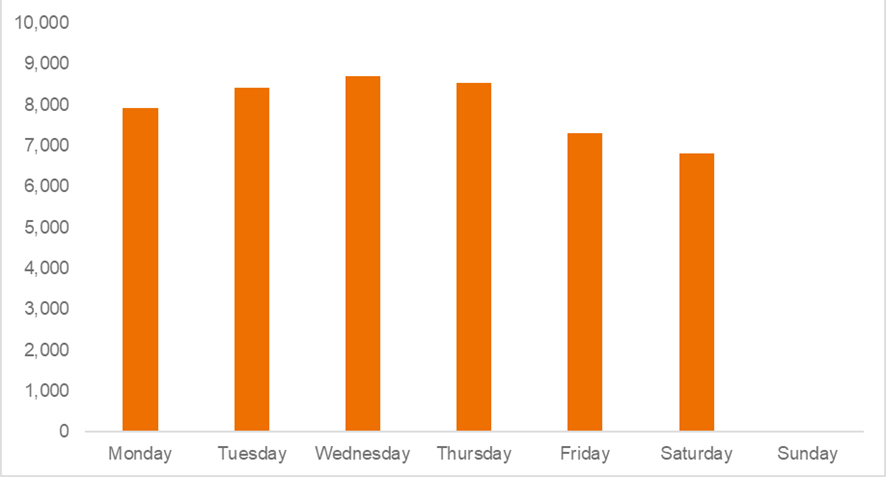
Carryings volumes are broadly similar across weekdays, although slightly reduced on a Friday. Saturday carryings are slightly lower than on a weekday on average. It should though be noted that the Saturday average is likely influenced by much higher carryings in summer and lower carryings in winter.
Key Point: Daily carryings are broadly consistent across the week and highlight the role of the route in supporting commuting.
Carryings by sailing
In order to understand the use of the route across the day, CFL provided sailing-by-sailing carryings data for calendar year 2022.
All sailings (both directions) from 2022 have been analysed based on their passengers carried per sailing. The figure below shows the number of times the ferry sailed with 0, 1, 2 etc up to the maximum of 100 passengers.
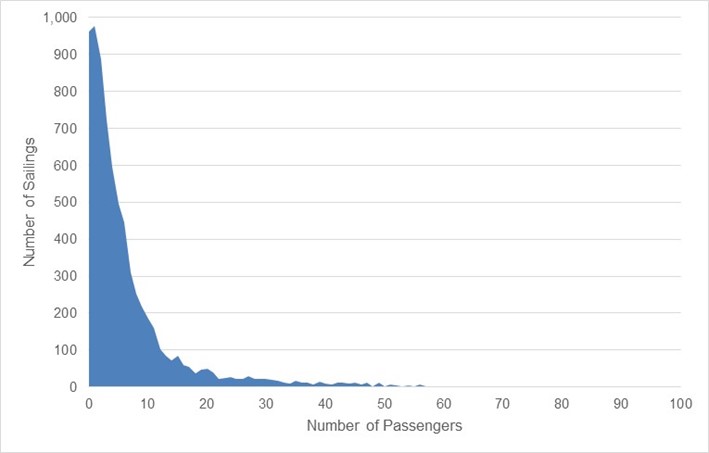
These data show that the very large majority of sailings carry relatively few passengers and the capacity of the vessel is far in excess of what is required, although this may to some degree be due to the seakeeping requirements of the crossing. From these data, it can be further implied that:
- 13% of sailings carried no passengers
- 49% of sailings carried fewer than 3 passengers
- 77% of sailings carried fewer than 8 passengers
- 91% of sailings carried fewer than 16 passengers
- Fewer than 1% of sailings carried more than 50 passengers
Gourock - Kilcreggan
The figure below shows the average carryings by sailing on the Gourock – Kilcreggan route for calendar year 2022:
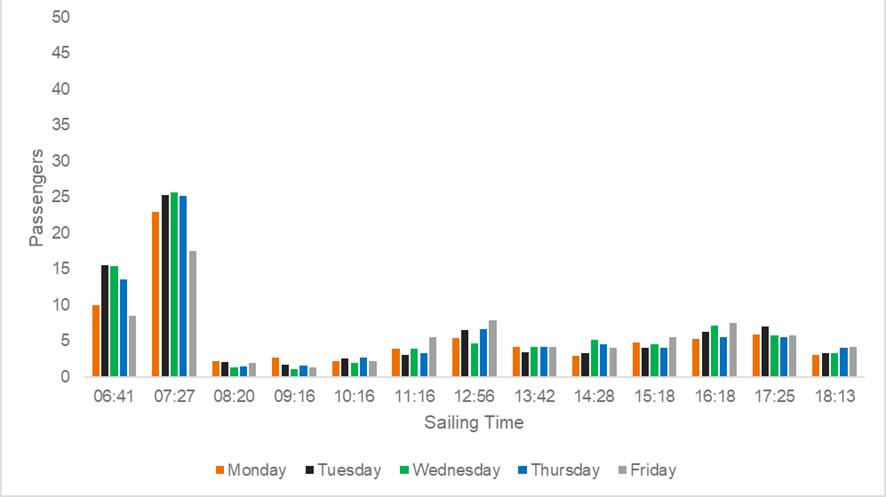
The main points of note from the above figure are as follows:
- The first two departures of the day from Gourock, the 06:41 and 07:27 are by some distance the busiest of the day. This likely reflects staff travelling to HMNB Clyde and, to a much lesser extent, RNAD Coulport.
- Outwith these two departures, carryings are typically very low with fewer than 10 passengers on average carried on each sailing, with many sailings operating with fewer than five passengers. There is little variation in the pattern of carryings across the week.
- If the 06:41 and 07:27 northbound commuter sailings are excluded, the average weekday passengers per sailing is four.
Kilcreggan – Gourock
The equivalent data are presented for the reverse direction, Kilcreggan to Gourock:
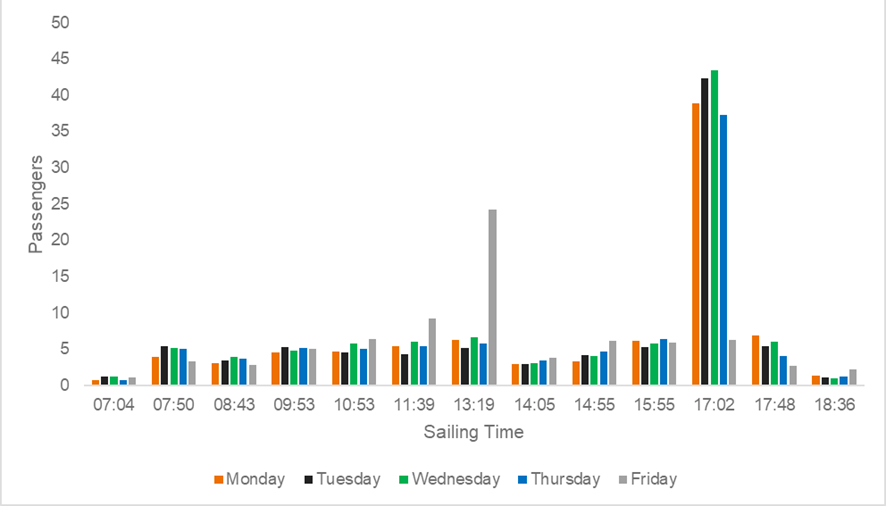
The Kilcreggan – Gourock direction is broadly the reverse of the ‘to Kilcreggan’ direction, with commuters from HMNB Clyde and RNAD Coulport returning to Inverclyde. Whilst in the morning ‘to Kilcreggan’ direction the demand is split across two sailings, almost all demand in the evening is carried on the 17:02 service.
The one outlier in the ‘to Gourock’ direction is a Friday. On this day, the dominant sailing is the 13:19 departure, with only five passengers on average being carried on the 17:02. This is due to an earlier finish time at HMNB Clyde and RNAD Coulport on a Friday.
As with the ‘to Kilcreggan’ direction, all other sailings typically carry very few passengers on average. If the 17:02 southbound commuter sailings are excluded, the average weekday passengers per sailing is five.
Key Point: The carryings by sailing highlight the inbound flow of commuters to Rosneath in the morning, largely bound for HMNB Clyde and RNAD Coulport. Outwith these peak weekday connections, all other sailings carry relatively few passengers.
Reliability
CFL produce equivalent reliability data for the Kilcreggan route as they do for the Dunoon route (i.e., the same definitions of ‘cancelled’, ‘lateness’ etc apply).
Cancellations
The figure below summarises cancellations on the Kilcreggan – Gourock route (both directions) for the previous 12 months (December 2021 – November 2022):
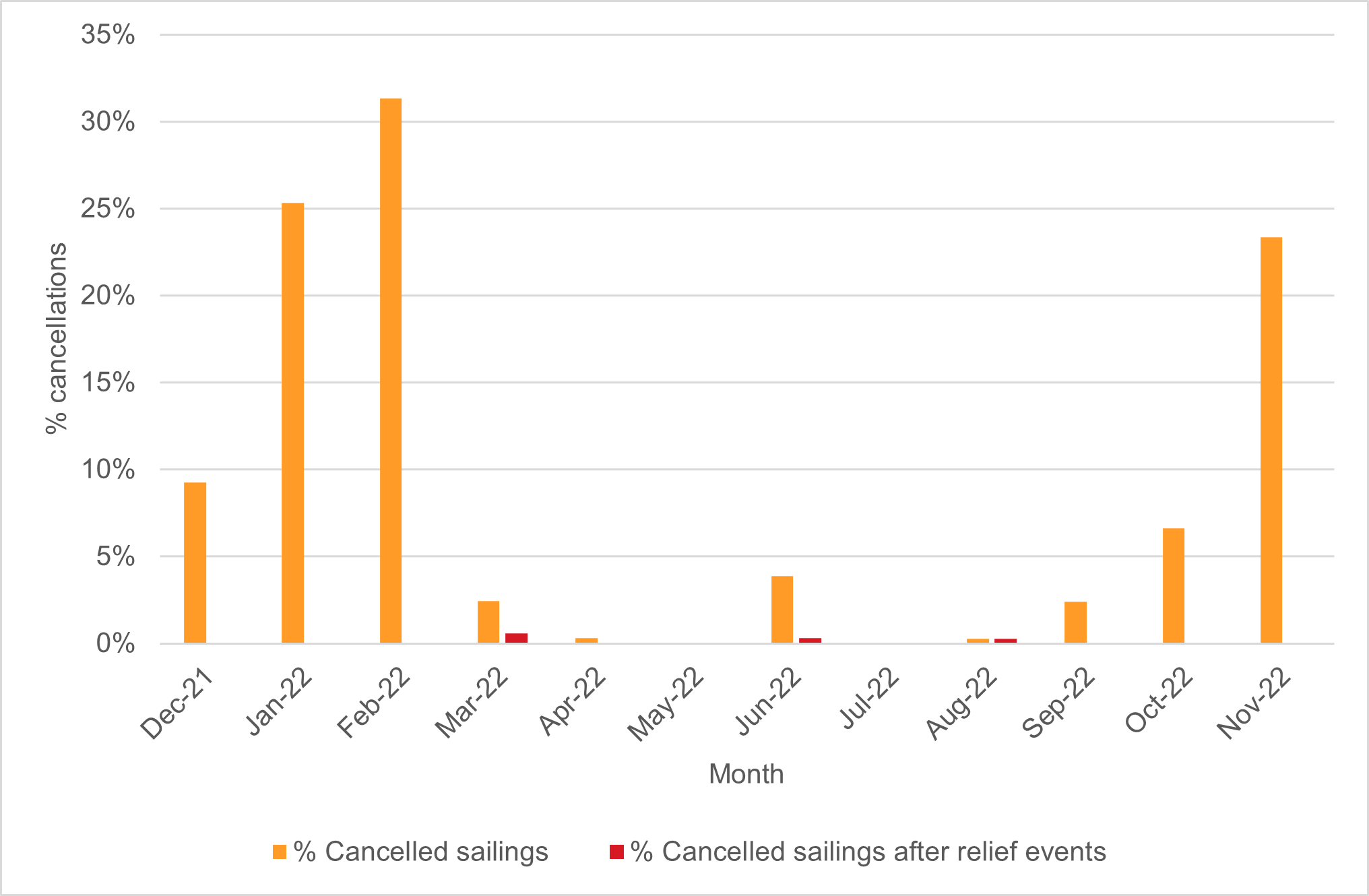
The main points of note from the above figure are as follows:
- There were significant disruptions in January and February 2022, which are in part understood to have been caused by COVID-19 related staff shortages. However, cancellations were also prominent on the Dunoon route in February 2022, highlighting that weather will have been a contributing factor.
- The cancellations in November 2022 were in large part caused by works at Gourock restricting the manoeuvrability of the vessel. This led to the introduction of a temporary timetable and a bus replacement service for certain sailings.
- Despite a series of one-off events which have affected the service in 2022, it is evident that the service is subject to weather-related disruption over the winter months but much less so in the summer months – this is reflected in the orange bars in the above chart, many of which will be weather-related cancellations. Moreover, sailings can also be cancelled due to the aforementioned tidal limitations with the service.
Key Point: The Kilcreggan – Gourock route has been affected by a series of potentially one-off issues over the period December 2021-November 2022 which have impacted its reliability. However, it is nonetheless evident from the data that the service is subject to a higher level of cancellations in the winter, whilst cancellations can also occur due to tidal restrictions.
Punctuality
As with the Dunoon route, analysis of performance data suggests that punctuality on the Kilcreggan – Gourock service is much less of an issue. When the service operates, it generally does so on time (on average, only 0.25% of sailings in the year December 2021 to November 2022 were late).
RSM Steps 1-4 – Rosneath
This section applies the Transport Scotland RSM methodology to the Rosneath Peninsula.
Unlike the Cowal routes, there has been no recent primary research on the Kilcreggan route, a particularly important issue given the range of factors that have affected route performance in recent years. The most recent survey work was carried out as part of the Ferries Review in 2009 and for a route specific study in 2011. To address this gap, a short online travel behaviour survey was undertaken in May 2023 to refresh the understanding of who is using this route, why and how often.
The following points should be noted with regards to the survey data:
- The research was undertaken in May 2023 and so reflects post-COVID-19 conditions, unlike the Cowal survey outlined in the previous chapter.
- The survey received 358 responses on a self-selecting basis, and so we do not know how representative this sample is of the Rosneath and Inverclyde (and beyond) communities.
- Connected to the above point, 72% (n=257) of respondents indicated that they live to the north of the Clyde, including 253 within the G84 postcode sector which covers the Rosneath Peninsula down to Helensburgh. On the Rosneath Peninsula, there has been much community attention paid to proposed pier upgrades at Kilcreggan in recent months. It is unknown whether the balance of respondents living north and south of the Clyde provides a true profile of users or whether a disproportionate number of Kilcreggan residents have responded to the survey given wider developments there.
- In analysing survey responses, it was evident that there was some confusion as to the meaning of respondents’ ‘final destination’, with a large number of respondents indicating their home area as their final destination. This impacted the responses received to questions relating to travel to / from arrival and departure ports. A disproportionately large number of people also noted their final destination as the ferry port, and so it is considered that some people have confused the end of the ferry journey as their ‘final destination’.
- Where appropriate, responses have been weighted by trip frequency.
Step 1: Identify the dependencies of the community
As the steps in the RSM process are set out in some detail in Chapter 3, they are not repeated in this chapter.
Commuting and frequent business use
Indicator 1: Island to mainland crossing time (in minutes)
The route crossing time is 13 minutes. As noted in Chapter 2, for journeys to Glasgow from Kilcreggan, the combined ferry and rail journey time is in all cases quicker than the overland equivalent via Helensburgh.
Indicator 2: Percentage of households who use the ferry service for commuting purposes and are also high frequency users
Commuting was by some distance the dominant travel purpose identified in the Kilcreggan – Gourock survey. In summary, when weighted for trip frequency:
- For those living north of the Clyde, commuting to / from place of work accounted for 43% (n=10,274 trips p.a.) of all trips on the ferry.
- For those living south of the Clyde, commuting to / from place of work accounted for 71% (n=9,360 trips p.a.) of all trips on the ferry. However, this accounts for a much larger proportion of overall journeys than those made from the north of the river. This reflects the commuting demand to / from HMNB Clyde and RNAD Coulport.
Key Point: Commuting is by some distance the dominant journey purpose when using the Kilcreggan-Gourock ferry service, amongst those surveyed, particularly for those travelling from Gourock to Kilcreggan.
Travel-to-work
In order to validate the potential use of the ferry for commuting purposes, 2011 Census travel-to-work data was analysed. Whilst now very dated, it is still the most recent national snapshot of travel-to-work behaviour.
As with Cowal, the data geography with respect to Rosneath is imperfect: the entire peninsula is covered by a single data area – ‘Garelochhead’ – and thus it is not possible to separate out the travel-to-work movements from the south of the peninsula where ferry use is likely to be more common. This is further complicated by inbound flows, most of which are bound for HMNB Faslane and RNAD Coulport, which combine various modes of transport for accessing Gourock, a ferry trip and then onward travel by bus, car driver or car passenger at the Kilcreggan side. The Rosneath data can be summarised as follows:
- There are 63 outbound journeys from ‘Garelochhead’ to Glasgow City Centre made by rail. A small proportion of these may involve using the Kilcreggan ferry and travelling via Gourock. However, the remainder will use Helensburgh Central and potentially other stations on the Argyle and West Highland Lines. The balance of trips by origin station is unknown.
- There are approaching one hundred public transport (‘bus / coach’) travel-to-work journeys between Inverclyde and ‘Garelochhead’. It is assumed that almost all of these journeys are destined for RNAD Coulport or HMNB Faslane and make use of the Kilcreggan ferry, either connecting with a bus service on the Rosneath side or making use of a second vehicle parked at Kilcreggan (or being a passenger in a second vehicle).
The monthly and daily carryings profiles do suggest that there is a base commuting demand throughout the year. Moreover, the individual sailings-based carryings also point towards a commuter market to RNAD Coulport and HMNB Faslane, with tidal flows to Kilcreggan in the morning and the reverse flow in the evening.
Key Point: It is difficult to determine the exact scale of overall commuting from the Rosneath Peninsula given the data geography. However, it appears likely based on the primary research that there is a rail commuter market to Glasgow (particularly from Kilcreggan itself), with at least some trips connecting via the ferry and Gourock railway station. Significantly however, there is a larger inbound flow of staff travelling to RNAD Coulport and HMNB Faslane, and therefore a dependency on the ferry to support this travel.
Mode of travel-to-work
The above origin-destination analysis is largely supported by mode of travel-to-work analysis, as highlighted in the figure below. Note that the mode of travel-to-work is reported at datazone level, a more spatially disaggregate level than the origin-destination data, which is reported at intermediate geography level.

The key points from the above figure are as follows:
- The proportion of residents in the Rosneath Peninsula who use the train as their main mode of travel-to-work is double the national average, which highlights the importance of the ferry connecting at least a proportion of these residents to Gourock (although some, and likely most, will travel via Helensburgh Central).
- ‘Other’ is marginally higher than the national average in Rosneath, which likely reflects those who consider the Kilcreggan ferry to be their main mode of travel-to-work.
Key Point: Whilst difficult to draw direct conclusions from the data, it is clear that the ferry services from Kilcreggan play some role in connecting labour to jobs. The ferry offers the quickest connection from Kilcreggan to Glasgow City Centre, in addition to Greenock and Paisley and from the Rosneath Peninsula more generally.
Indicator 3: Percentage of households who use the ferry service for business purposes and are also high frequency users
The survey found that 4% (1,608 trips p.a.) on the Kilcreggan – Gourock route were for ‘business / self-employed / employer’s business’ purposes. Of these trips, 67% (n=1,070 trips p.a.) originate on the Rosneath side of the crossing.
Key Point: There is relatively little business travel on the Kilcreggan ferry given the limited industry in the village itself and the accessibility of the Rosneath Peninsula by car.
Dependency rating
The pattern of carryings on the ferry and the route user survey does suggest that commuting is a primary purpose of this route. Somewhat unusually for communities of this nature, there is a two-way flow of Kilcreggan residents travelling for work and commuters travelling to the peninsula to access RNAD Coulport and HMNB Faslane. For this reason, this route is classed as having a ‘Pot B’ dependency.
Personal
Indicator 4: Population
2,991 people are estimated to reside within the Rosneath Peninsula according to the National Records of Scotland Small Area Population Estimates 2021.
Indicator 5: Percentage of households who use the ferry services for health-related purposes
Kilcreggan and Rosneath more generally is part of NHS Highland. There is a General Practice in Kilcreggan but travel off the Rosneath Peninsula is required for all other medical needs. Patient travel from Rosneath, both in terms of destination and mode of travel, is not well-understood.
The survey suggests that 5% (n=1,784 trips per annum) of all trips on the Kilcreggan ferry are for health visits. As would be expected, the Rosneath Peninsula is the origin for almost three quarter of these trips (indeed, it would be expected that this figure would be higher given that there are likely to be few health visits to Rosneath, so this may reflect an inaccuracy in how respondents have answered the question, e.g., visiting an unwell resident or health service providers selecting this option).
Indicator 6: Frequency profile for all travel using the ferry service
Respondents were asked for what purpose they mainly use the Kilcreggan ferry, and how frequently they travel for this purpose. Journey purpose data were weighted by trip frequency to estimate the purpose split of trips made using the ferry.
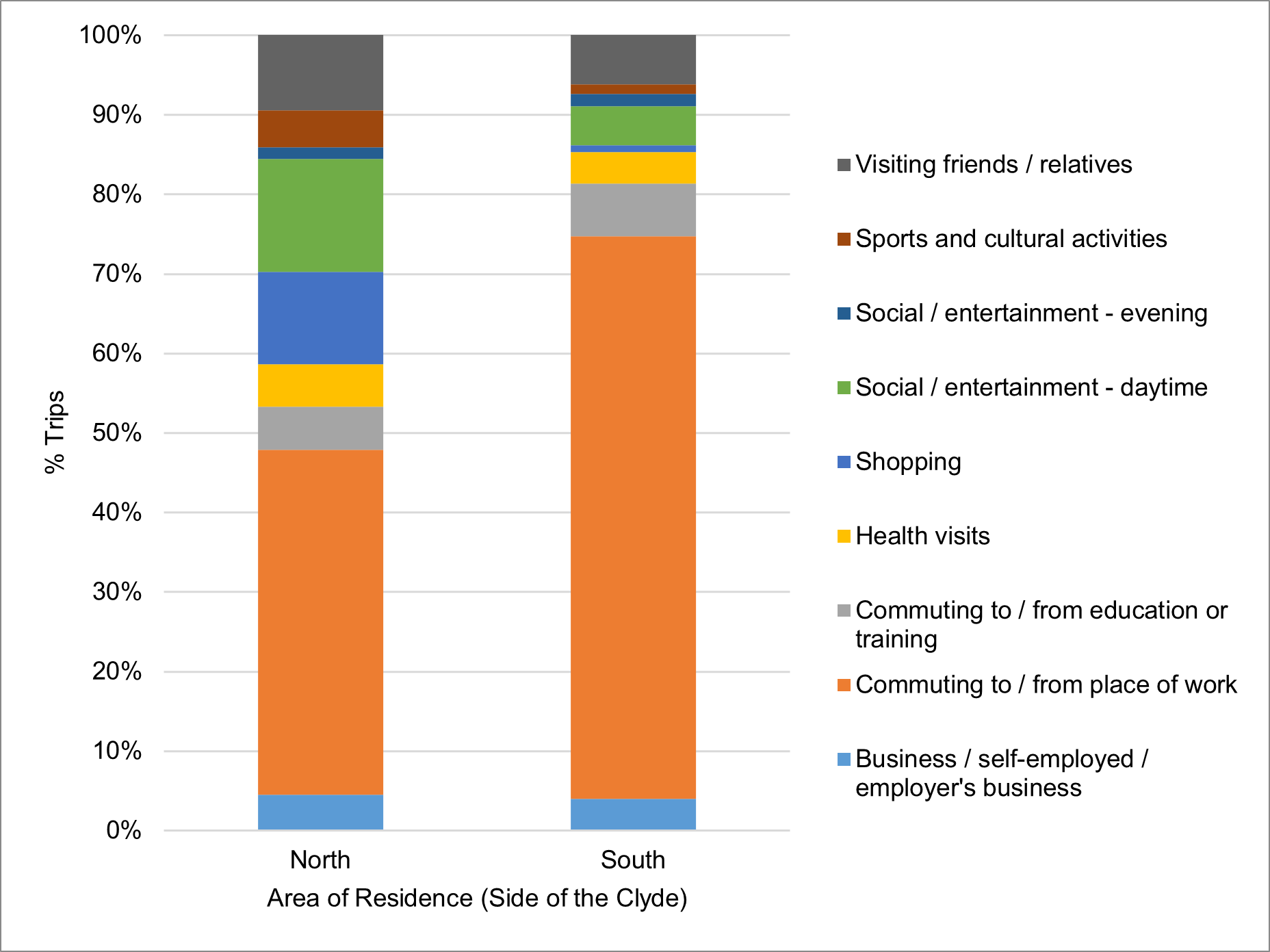
The main points of note with regards to journey purpose are as follows:
- In terms of the number of trips, the most common trip purposes for those living to the north of the Clyde outwith commuting are daytime social / entertainment (14%, n=3,370 trips p.a.) and shopping (12%, n=2,742 trips p.a.).
- Only 18% of journeys made from the south of the river are for a purpose other than travelling to work, education or for business. Of these, visiting friends and relatives (6%, n=814 trips p.a.) and social / entertainment – daytime (5%, n=648 trips p.a.) are the most common travel purposes, but absolute volumes are low.
Key Point: In the ‘to Gourock’ direction, the ferry plays an important role in facilitating travel for a wide range of leisure purposes.
Dependency rating
Whilst one of the main reasons for passengers using the Kilcreggan – Gourock route is for personal business and leisure purposes, the allocation of a ‘Personal’ dependency to the route would imply an ‘Extended+’ operating day (i.e., more than 14 hours), which would represent a major ramp-up in the service in the face of very low demand. For this reason, a ‘Pot C’ dependency is allocated.
Freight
Unlike Cowal which has a reasonably large freight market served by Western Ferries, there has never been a car ferry service between Rosneath and Inverclyde. Freight arrangements for businesses in Kilcreggan and Rosneath more generally will be served as part of a wider trunk distribution network covering Helensburgh, Lomond and Argyll & Bute. The market is too small to merit moving freight on a car ferry from Inverclyde with the cost that this would entail. This ‘dependency’ (and thus ‘Indicators 7-9’) is therefore not relevant in this context.
Tourism
Like Dunoon, Kilcreggan and other settlements around the Rosneath Peninsula were historically part of the Firth of Clyde day tripper and short-break market. Again, whilst this market is now much diminished, tourists do continue to travel to Rosneath for a range of purposes including cycling, events etc, although the balance of this travel between car, bus and ferry is not well understood.
Indicator 10: Percentage employed in tourism
The figure below displays the percentage of the workplace jobs employed in BRES sector I: ‘Accommodation and Food Service Activities’, as a proxy for the tourism industry.
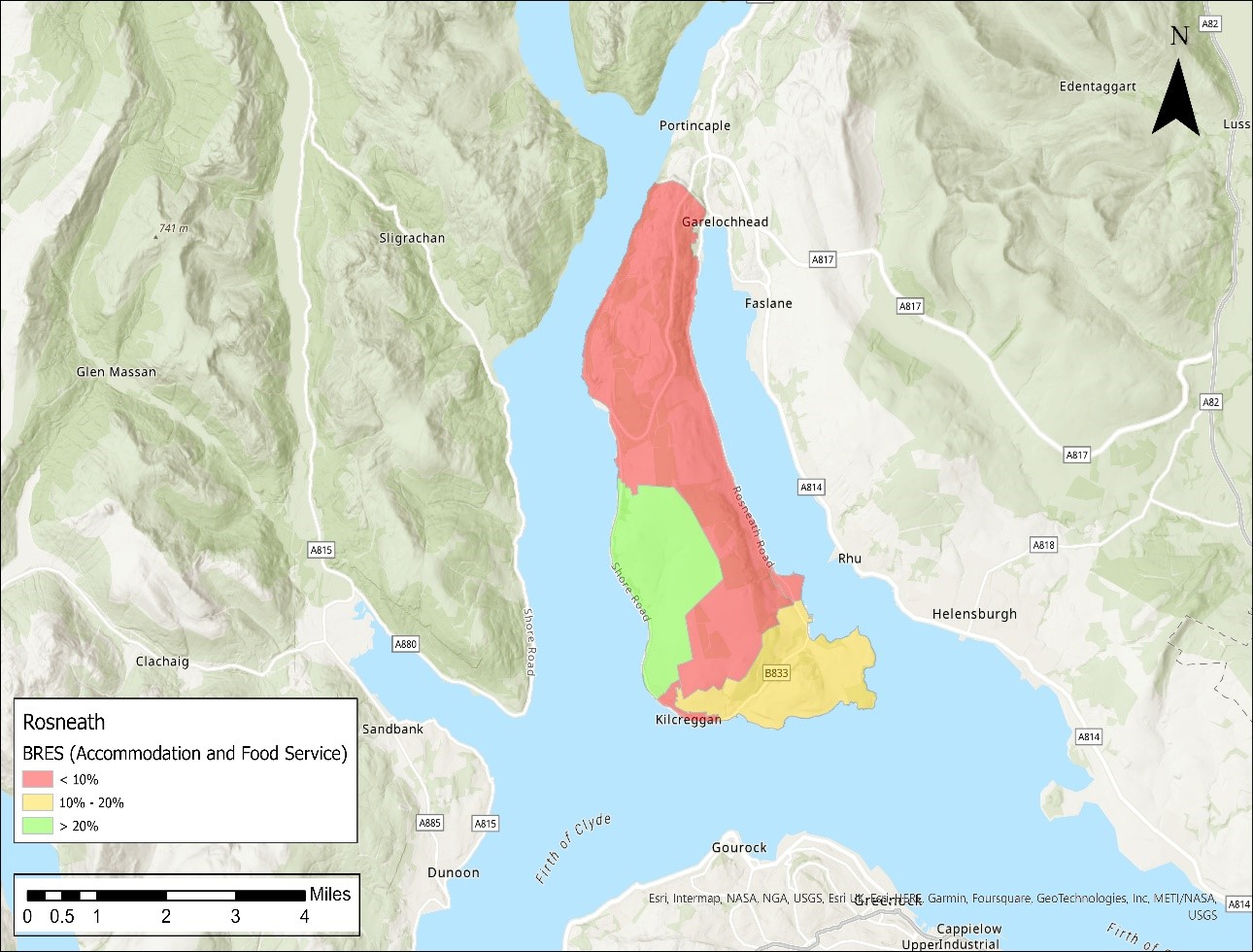
As can be seen from the above figure, there are in relative terms significant workplace employment concentrations in tourism-related businesses in the south and west of the Rosneath Peninsula. This is where the majority of self-catering and serviced accommodation is located, together with associated leisure facilities and pubs / restaurants. Whilst however significant in proportional terms, absolute numbers employed in this sector are extremely small, with RNAD Coulport being by some distance the dominant employment site. Indeed, only 3% of total workplace employment in the peninsula is in ‘Accommodation and Food Service Activities’, which compares to the Scotland average of 7%.
From a TTWA perspective, Rosneath is grouped with ‘Dumbarton and Helensburgh’ and therefore any local insights will be drowned out by these much larger settlements.
Key Point: The BRES data indicate that tourism accounts for a small proportion of workplace employment overall in the Rosneath Peninsula, although there are several important tourism businesses in the area, e.g., Rosneath Castle (holiday) Park.
Indicator 11: Share of summer patronage versus share of population
In the calendar year 2022, the Kilcreggan Gourock route carried 47,659 passengers. Of these almost two thirds (64%) were carried in the summer (April – September inclusive), with the remaining 36% carried in the winter. That said, major disruptions to services in January and February 2022 depressed winter carryings to some degree. The analysis of carryings data from previous years highlights that the majority of carryings are in the summer, but the proportions are perhaps not quite as stark as for the year just past.
July and August are however undoubtedly the peak months. In the 2022, 27% of total annual carryings were accounted for by these two months. This highlights that there is a summer tourism uplift layered on top of the core demand. The seasonal variation on the Kilcreggan - Gourock route, despite being significant, is less than on many other routes in the Clyde and Hebrides due to the high baseload of commuters.
Key Point: The majority of annual carryings (64%) on the Kilcreggan – Gourock route are in the summer months (April to September). Whilst the figure for the last year may be distorted by one-off reliability issues in winter, it is evident that there is a significant peak in ferry usage in the school holiday months of July and August, pointing towards high levels of daytripper tourism in both directions.
Dependency rating
Whilst there is evidence of tourism demand for the Kilcreggan – Gourock ferry, the nature and directionality of that demand is not fully understood (the 2023 route survey was undertaken in May and will not capture the peak summer daytripper market). It could consist of a mix of: (i) Rosneath residents travelling to Glasgow and surrounding areas during the school holidays; (ii) daytrippers to the Rosneath Peninsula; or (iii) those staying one or more nights on the Rosneath Peninsula. Each of these markets has very different travel needs.
The allocation of a ‘tourism dependency’ for this route would imply an ‘Extended+’ operating day (i.e., more than 14 hours) but it is unclear from the evidence as to whether this is actually required. For this reason, a ‘Pot C’ dependency is allocated. A ‘Pot D’ dependency would apply in winter.
Dependency Summary
The table below summarises the dependencies for the Rosneath Peninsula:
| Dependency | Rating |
|---|---|
| Commuting | B |
| Personal | C |
| Freight | Not applicable |
| Tourism | C (summer) / D (winter) |
Step 2 – Development of the model service
The resulting model service for Rosneath is shown in the table below:
| Dependency | Rating | Sailing days | Sailings per day | Operating day (summer) | Operating day (winter) |
|---|---|---|---|---|---|
| Commuting | B | 7 days | Freq. Peak | Specific | Specific |
| Personal | C | Not applicable | Not applicable | Not applicable | Not applicable |
| Freight | Not applicable | Not applicable | Not applicable | Not applicable | Not applicable |
| Tourism | C/D | Not applicable | Not applicable | Not applicable | Not applicable |
| Summary | Not applicable | 7 days | Freq. Peak | Specific | Specific |
Step 3 - Define the current ferry service profile
The RSM guidance suggests that the definition of the current ferry service should take account of both summer and winter timetables. The review of the Kilcreggan – Gourock timetables presented in Chapter 2 highlights that the timetable is broadly consistent year-round. We have therefore focused the definition of the current ferry service on the standard summer timetable.
Using the RSM definitions, the current Kilcreggan – Gourock service is described below:
- Six days per week, year-round.
- Thirteen sailings per day, Monday-Friday, operated broadly at one per hour.
- Twelve sailings per day, Saturday, operated broadly at one per hour.
- Operating hours are 12 hours 8 minutes Monday-Friday and 10 hours 45 minutes on Saturdays.
In summary:
- There are no sailings on the Kilcreggan – Gourock route on a Sunday.
- The service operates on a broadly hourly frequency Monday – Saturday, although there is one sailing fewer on a Saturday because the service commences slightly later.
- The operating day is broadly that which can be delivered by a single crew and facilitates a working day in Rosneath, Inverclyde, Glasgow etc.
Step 4 – Comparison with current services
This step requires a comparison between the proposed and current service profiles to identify whether gaps exist in service provision. This is again a largely prescribed process within the RSM guidance.
Gap Analysis
The table below provides an indication of the gap analysis undertaken.
| Dependency | Sailing days | Sailings per day | Operating day (summer) | Operating day (winter) |
|---|---|---|---|---|
| Model | 7 days | Freq. Peak | Specific | Specific |
| Current | 6 days | Freq. Peak | Standard | Standard |
| Gap analysis | Marginal under-provision | Sufficient provision | Marginal over-provision | Marginal over-provision |
The application of the RSM process identifies the following with regards to the Kilcreggan – Gourock route:
- ‘Marginal under-provision’ in terms of the number of sailing days, given the absence of a seven-day service.
- ‘Marginal over-provision’ in terms of the length of the operating day.
Each of these areas of over-provision is now discussed in turn.
Sailing days
The RSM implies that communities should have sailings seven days per week where this is wanted, and in this respect the Kilcreggan route is under-provided. From our initial review of shift patterns, it appears possible to deliver a Sunday service within the hours of work regulations, but these are legal maximum hours and may differ from employees’ contracted hours.
Irrespective, as all sailings would require a subsidy to operate, the material question is the case for running Sunday services in terms of the outcomes which would be delivered. Moreover, there would be a question over the extent of any Sunday service – i.e., would it be a near full timetable service as happens on several routes in Shetland or a minimal timetable as happens on several of the short routes in Orkney. It is worth noting in this respect that Rosneath residents can travel by bus and train to Glasgow although, as previously explained, bus service provision to / from Helensburgh on a Sunday is limited.
Length of operating day
The RSM suggests that the length of the operating day should be ‘Specific – at peak times, not prescribed’. Again, the guidance does not clearly define what this means, although it would suggest a sub-11-hour day as the next ‘profile’ up is ‘Standard’, which implies an 11-hour day, 07:00-18:00.
As with Cowal, the logic of running a ferry service on a short route with a commuting ‘dependency’ over a sub-11-hour day simply does not hold. On this basis, there appears no case for reducing the length of the operating day on the Kilcreggan route.Indeed, potential synergies with the Dunoon route could be considered in terms of providing additional evening sailings at little marginal cost.
Next Steps
Having defined the current and model service and gaps in provision therein, Chapter 5 sets out options for addressing these gaps in provision. The focus for the Kilcreggan – Gourock route will largely be on:
- Whether there is a case for delivering a Sunday service and the mechanics of doing so.
- Any opportunities for realising economies of scale with the CFL Dunoon – Gourock route, including during the evening.